So, it’s official. Shou wu chih is great for sleep! I’ve been taking Shou wu chih on and off for a long time. I started to suspect that it helped deepen sleep last year. I can say every time I drink Shou Wu Chih I get a great night’s sleep. I’m not really sure what the reason is for it, but it works. As I mentioned in previous posts, there is a version with alcohol out there. Drinking a few ounces of this will definitely make you sleepy, however you should wake up refreshed. Regular wine doesn’t have this effect on me, but shou wu definitely does.
Hmmm, does it contain melatonin?
Irish Moss – Jamaican Power Drink
How does great skin, a strong “back”, virility and awesome taste wrapped up in one drink sound? Sounds great to me, so that’s why I’m introducing you to a little known Jamaican treat called Irish Moss or Sea Moss. Chrondus Crispus is a variety of seaweed that is found in coastal regions of North America, the Caribbean and parts of Europe. Many of you have heard of the thickener, Carageenan, which comes from this seaweed. It’s popular is Scotland and Ireland as the main ingredient in pudding. It’s high in Sulfur and other minerals and is touted as male performance booster. Here’s how you make it:
Ingredients:
- Irish Moss
- Flax Seed (aka Linseed)
- Condensed Milk (I use skim milk to lower calorie content)
- Spices–Nutmeg,Cinnamon,Vanilla
- Optional-Gum Arabic
- Optional-Isinglass (Agar)
- Optional-Sugar or Sweetener to taste
- Optional but recommended-Wray and Nephew White Rum
This is how one of the good Irish Moss packages looks like and where to get it.
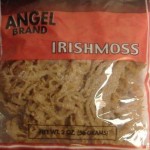
How to Make it:
Note:I tend to shy away from listing exact amounts. Experiment, you can’t go wrong.
Some people recommend soaking the irish moss overnight first with some lime juice. I found it’s not necessary. Just rinse it and take off any particles. Put in a pan with water to cover and a bunch of the flax seeds and the optional agar and Gum Arabic. Bring to a boil and simmer until the Irish moss melts away (could be an hour or more depending on how much seaweed you’re using). I recommend starting small until you get the hang of it. Keep an eye on it because it can boil over and make a huge mess on your stove. You can use a fork or one of those hand blenders to speed it up. Put in the vanilla and spices with milk and sweetener. Add the Rum if you want an extra kick.
Be creative. Everytime I drink this mixture, my skin looks great for days afterwards. It must have some kind of nitric oxide, PDE-5 inhibition or related effect because this stuff is seriously powerful and works.
Ideas to enhance the effects:
- Boil in some peanuts or peanut butter. If using raw peanut, try to include the skin
- Add a Jamaican Root Drink (these are bitter herbs with reputed aphrodisiac and healing power)
- Try adding Carrot Juice
- Ginseng Extract is often added
- Various combinations of Banana and Oats are also often used
- Gingko extract is sometimes added
Take the time to make this drink and enjoy it’s tonic effect. You’ll be glad you did!
Ching Chun Bao — Antiaging tablets from China
Ching Chung Bao also spelled Qing Chun Bao is an interesting tonic I found while on my quest for Shark Oil.
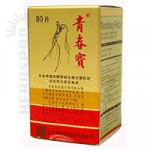
It’s meant to be taken twice a day and over a long period of time. The bottle says, “Main functions: Postponing aging, maintaining youthful face, enhancing youthful vigour.” Sounds good to me!
These are the listed ingredients:
- Ginseng
- Rehmannia Root
- Chinese Asparagus Root
- Siberian Solomon Seal
- Cistanches
- Goji Berries
- Astragalus root
All of the above are Tonic Herbs. As long as there aren’t any hidden ingredients, I think this is a superb formula to take over time. Everyone’s heard of goji berries and ginseng. Solomon Seal is a wonderful lesser known tonic that is said to help restore your body after stress and over indulgence. Cistanches is a great nitric oxide enhancer and probably a decent pde-5 inhibitor (must research that sometime). Astragalus is another great tonic and has a reputation for enhancing your immune system. You should be able to find it for about 8 usd a bottle.
Generally, and according to the traditional chinese medical system, all of these types of tonics that benefit the kidney and liver system are good for anti-aging because those are the systems that are mostly responsible for keeping us young. They govern the condition of your hair, teeth, bones, connective tissue, memory, sex drive and youthful vitality. Check out the jing post on this site for more info.
Although this one is interesting, I doubt I can commit to taking it religiously twice a day. Anyone interested in trying this one out?
Shou Wu Chih 3 Month Update
It’s roughly 3 months now that I’ve been drinking Shou Wu Chih fairly regularly. It’s hard to take something almost every night even with free dailynudge reminders sent to my cellphone! Daily Nudge. Because it has a fair amount of alcohol in it, I didn’t take it on nights I had a few drinks or got caught up with work late into the evening. It’s non stimulating, so I find it’s a superb tonic to take before bed.
I do have to say, that my hair is much much darker. I haven’t found a hair with a dark root yet, but overall my hair is darker. Why the hair is darker is hard to say. More oil? Any experts out there?
Other benefits
If you read my first post on this product: Gray Hair Experiment you will notice that Shou Wu Chih is one of the more effective tonics out there. It’s taken to restore energy depleted from too much sex or stress. This is a good one to have and it’s certainly not expensive. I’ve been finding mine in a asian grocery store for just a few dollars. And it tastes good!
Fenugreek–Interim Results
I’m a little disappointed with Fenugreek. I have three forms of it:
- Crushed Seed
- Powdered Seed
- Testofen Extract
For the first few days of taking the crushed seed, I felt a distinct energy boost. I also felt there was a nitric oxide enhancing mechanism, but could not really find strong evidence on the net. Eagerly, I tried the Testofen Extract because it was getting rave reviews over at Bulk Nutrition. However, I have to give this one a thumbs down, I’m not noticing anything sustainable. I must have had a placebo type reaction for the first two days because I was singing it’s praises! The powdered seed just made me feel really tired. I’m not interested in experimenting anymore with it.
Verdict: If you’re interested in trying Fenugreek, I would recommend the crushed seed. There’s something to it that is sustainable over more than a few days, but don’t expect any big miracles. I’m not sure I can really consider this one a tonic.
Jamaican Roots
Jamaica is a relatively small island but it contains a wealth of tonics. Health consciousness permeates almost every aspect of the culture. You can’t eat anything in Jamaica without being reminded of the health benefit or reason for eating it.
One popular beverage is called ‘Roots’. It comes by many colorful and descriptive names. If you look for ‘Wood Root’ or ‘Roots’, you should be able to find it. One very popular one is this one:
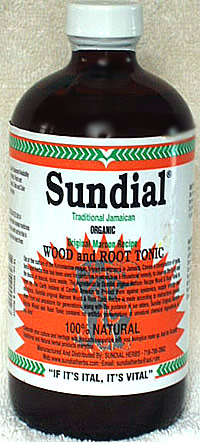
There are about as many different formulations as there are names for this drink. Some are extremely bitter. Some are sweetened and fermented.
Jamaicans say these drinks are ‘good for the back’. You need a strong back to accomplish things in life, among other things.
Try it and report back!
Horny Goat Weed?
Despite it’s unfortunate name (who wants to bring this stuff to the counter), Horny Goat Weed or Epimedium, is an amazing chinese herb. Bodybuilders take it for increased testosterone (weak anecdotal evidence) and for the ‘pump’ (very strong evidence). It’s also thrown into herbal preparations for PDE-5 inhibition effects (very strong scientific evidence).
I like to check http://www.pubmed.com for scientific experiments related to the herbs and supplements I’ll be discussing here.
It’s very cheap as a raw herb you can purchase in any chinese herbal shop or over the net. It’s basically dried leaves packed tightly into little bricks that resemble a pack of dollar bills.
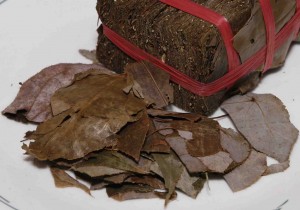
Scientists have found that it has strong Estrogenic qualities. What?? Yes, despite all the hype around male performance, it has been shown effective for woman going through menopause and for the prevention of Osteoporosis! Check out pubmed for the studies.
One substance that has been isolated from epimedium is a chemical called icariin. Again, check pubmed for this one. It’s PDE-5 inhibition rivals viagra. In fact, one study mentioned how they were working on derivatives of icariin to produce even more effective inhibition. Do your research! Check pubmed, don’t just believe me.
Despite all the clinical evidence pointing to epimedium being estrogenic, this herb has a strong reputation for being a testosterone booster. I think it’s probably due to it’s PDE-5 inhibition that get misinterpreted as libido enhancing. Another possibility is that the body absorbs these natural weaker estrogens instead of the dangerous estrogens purported to be in our drinking water, detergents and certain food additives. So it could have a protective effect against those dangerous substances. I haven’t studied the estrogen story in depth, but there seems to be strong suggestions that our environment is polluted with toxic estrogens.
Eucommia Ulmoides
This herb always caught my eye in the herbal shops. It has a really odd name too–Eucommia Ulmoides.
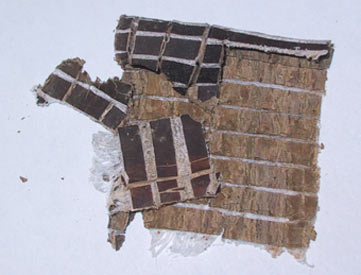
The chinese name is “Du Zhong“.
This is an herb that could be made into a tea without any additional herbs. It can stand on it’s own. Traditionally, it’s used to lower blood pressure (read Nitric Oxide). Interestingly enough, it’s also used to treat back pain and weakness of the legs. It’s recommended for muscle/tendon injuries and impotence.
Look at the picture closely. The white fibrous part is reputed to be the reason why it is good for our fibrous muscles and tendons. The herb has a rubbery feel to it.
One traditional recipe is to boil it with Oxtail for a stew. Don’t use too much. I’ve ruined a few soups by putting too much Eucommia in it. It doesn’t taste very good. I found powdered Eucommia and a teaspoon mixed with tea is not too bad, you can barely taste it.
I haven’t really tested this one. I do have an injury I can try it on. I’ll see how it goes. If anyone else wants to committ to trying this one and report back please do!
Gray Hair Experiment
One of my all time favorite tonics is something called ‘shou wu chih‘ and it’s found in any chinese herbal shop or asian grocery. It looks like this:
The main ingredient in Shou Wu Chih is an herb called polygonum multiflorum. There’s a raw version of this herb that is sold in many herbal tablets for hair loss and graying.. However, traditionally, the raw herb is specially prepared by boiling it in a broth made primarily of black soy beans and then carefully dried. Many people don’t know this, but if you’re interested in this herb for it’s reported hair benefits, you want the prepared herb, not the raw version.
This herb is also called FoTi and He Shou Wu. You’ll probably encounter just as many spellings and pronunciations as you can imagine. You’ll also find countless variations of the legend that states a person who was gray haired and really old, ate this herb and became young again with dark black hair. I’m told in chinese, he shou wu means something like ‘mr. he black hair’.
Many people familiar with Chinese Medicine take this tonic everyday in hopes it will either darken their hair or keep it from turning gray. There is another benefit–this is also a very good overall tonic that is supposed to benefit the ‘Jing‘ if you are depleting your energy from stress or other activities (read my post on Jing-Chi-Shen). It’s purported to be a reliable youth tonic and powerful libido enhancer. I really like the taste of this one. There are two versions–one made with alcohol (it’s labeled ‘cooking wine’ in some stores) and one made with water.
I could go into all the other ingredients, but you could google it. There’s a wealth of information on it.
The Experiment
So, I’m not happy that I sprouted some gray hair on my temples and scattered throughout what used to be very black hair. I’m going to take this everyday and report on results after a few months. If I see some gray hair with dark roots coming in, I will claim this a success.
I’m thinking about picking this up as well:

Shou Wu Pian is a concentrated version of the single herb in a small black pill. It’s supposed to be taken for a long period of time to see results. I think I may add this to the regimen.
The products are in my amazon store on this page. Your best bet if you live near a metropolitan area or asian community is to buy it yourself. These products are inexpensive. Try my links or search the web for a better deal. In the future, I may setup a store. Let’s see…
Extracts vs Powders
I recently went to visit a local Chinese Herb shop to get an herbal ‘tune-up’. Many years ago, I found a great chinese herb shop and whenever I felt rundown, I would get my pulse read by the old resident herbalist and he would write out a prescription for the pharamacist to combine together and grind up. I would then boil the ground up herbs and drink a cup twice a day. I always felt like a million bucks afterwards and I recommended them to all my friends and family. Unfortunately, the place burned down one night and I never saw or heard from them since. I haven’t been able to find a good herbalist since.
Anyway, I tried out this new place and when I went to pick up my herbs, I got a bunch of packets of powder I was supposed to mix into a cup of hot water and drink. The herbalist told me this was the new way to dispense herbal prescriptions. I didn’t really like this, but decided it was worth a try.
Extracts have some merit. Always make a note if you are dealing with a raw herb or with an extract. Extracts are just that..alcohol or water or some other chemical extraction of the chemicals in the herb. Extracts are very potent and come in varying strengths such as 5:1, 10:1, 100:1 etc. Extracts are usually standardized to contain a certain percentage of the known active chemical, which I guess makes it more like a drug, but guarantees you are getting a standard and expected dose. As an example, I don’t think 500 mg of powdered gingseng is going to have much effect on anyone, but 500 mg of a powerful ginseng extract certainly could.
The problem with extracts is that they could be missing important chemicals that are not understood or known that are vital. I always felt a water extract would miss chemicals that were not water soluble or an alcohol extract could miss ingredients as well. But I’m not a chemist, so I’m not really sure about that. I’ve noticed really powerful effects from extracts (which I’ll go into detail in future posts) so I know they work. At the same time, I’ve had great effects from boiling bulk herbs too. I can’t really think of a good experience with a raw powdered herb off the top of my head, I think they are largely ineffective because the dosage is so small.
In either case, one is probably not always better than the other and each will have it’s place. For now, just make sure you know what you’re dealing with and what you’re paying for. Read those labels to see if you’re getting an extract or just a few milligrams of a powder.
Oh, and my experience with that new herbalist was terrible. I don’t think mixing individual extracts of the herbs into hot water is the same as the raw herbs. I didn’t feel better, in fact I felt worse and threw the rest out. I’ll never go back there.
By the way, and this is a topic for another post, I don’t think the herbs we get now are anywhere near what they used to be in the ‘old days’. But I digress…
Chyawanprash — Ancient Elixir From India
Chyawanprash is a well known tonic from India. It can be found in almost any indian grocery. It looks like this:
It’s a combination of various herbs and spices (depending on source) but they all should have a base of honey and clarified butter, called ‘ghee’. It has an odd sour and sweet taste. Some formulations could have up to 80 ingredients, according to Wikipedia.
Everyone I speak to from India knows about this tonic and many say they were forced to take it when they were young. One person told me it was to build muscle and make someone strong.
I’ve tried it and I have to admit I didn’t feel any immediate benefits from it. For some reason, I just can’t commit to taking it regularly enough to say one way or the other. I think it’s an interesting tonic because the principle ingredient is amla, which is supposed to be a powerful antioxidant. I also noticed it contains tribulus, which is another herb touted to improve testosterone levels.
I’m including Chyawanprash because of it’s popularity and to see if anyone has any direct experience with it to say ‘yay or nay’. There’s a ton of marketing material on this one, so it’s difficult to sort through what’s real and what’s hype.
Jing Chi Shen
As I come across interesting theories and paradigms, I’ll be writing about them here.
One very helpful paradigm for comparing items on this site comes from Traditional Chinese Medicine (TCM) and it’s view of the body’s energy system. In TCM, there are three concepts called ‘Jing Chi and Shen‘. There aren’t very good english equivalents for these terms, but loosely translated, ‘Jing’ means the core energy you were naturally alloted at birth. One can think of this as the size of your energy battery you are given. There are alot of really esoteric ideas concerning how this ‘Jing’ size is determined but it largely is inherited from the parents and the circumstances around conception. Interestingly enough, this concept is not unique to TCM, but is found in many Spanish cultures as well. The bottom line is, according to this theory, when your Jing starts to fall short, you grow old and eventually die. We’ll be looking at strategies to make the most of our Jing on this site.
Next is ‘Chi‘. I’m sure everyone has heard of ‘Chi’ and it’s alternate spelling, ‘Qi‘. Chi can be thought of as your energy level and ability to accomplish things in the world. People who get a lot done and rarely get sick are said to have alot of ‘chi’. Chi is also thought of as the ingredient of the flow of ‘energy’ in the body (primarily via fascia) and many TCM doctors aim to get this flow properly balanced in the body through herbs, acupuncture, etc. The amount of Chi we have can be augmented by diet, certain practices (which we’ll be exploring too) and through sleep. However, the amount of basic Jing is an important driver for how much Chi someone has (according to this paradigm).
Just to be clear, I’m not crazy about vague terms like Jing Chi Shen, but just bear with me. I think this is a good model to have in our arsenal for the quest.
The last concept, ‘Shen’ is loosely translated as ‘Spirit’. This is often seen in the eyes and people call it ‘charisma’ or ‘aura’. How much chi you have drives your spirit and charisma.
In TCM, many herbs are said to operate on one or all of these levels.
A very common analogy is a candle. The wick is compared to Jing. The wax is compared to Chi and the flame is compared to Shen.
I read this book many years ago and found it to have a good explanation of these concepts and pretty decent overview of many herbs and tonics medicines from China.
Cured Brain Fog!
I wanted to share a supplement I found that I feel has helped cure brain fog. Of course, if you read my inaugural post, it could be just a coincidence, so I’m putting this out there to see what others think. I was experiencing extreme brain fog after some stressful life circumstances. Thinking it was tied to allergies, I took Claritin to no avail. I tried several other supplements to address this problem including choline and phosphatydilserine, but nothing seemed to be working. Until I came across this at the local asian supermarket:
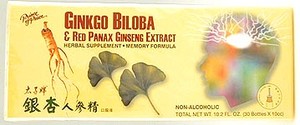
I took three vials a day, which provided a whopping 7.2 grams of Gingko Biloba Leaf Extract and 1.5 grams of Red Panax Ginseng Root.
This is a liquid extract in a vial. The box comes with little straws and a plastic tool to puncture them. The other ingredients are honey, water and less than .05% alcohol.
In about three days, I noticed the brain fog was lifted and my mood improved. I know from experience that both Gingko and Ginseng boost dopamine levels. I was pleasantly surprised to find my thinking clear and my concentration improved.
I did some light research on this later and found the combination of ginseng and gingko has been studied pretty extensively. Check out: http://findarticles.com/p/articles/mi_m0ISW/is_2002_June/ai_86387585/ for some interesting studies.
This one is a keeper for me.

